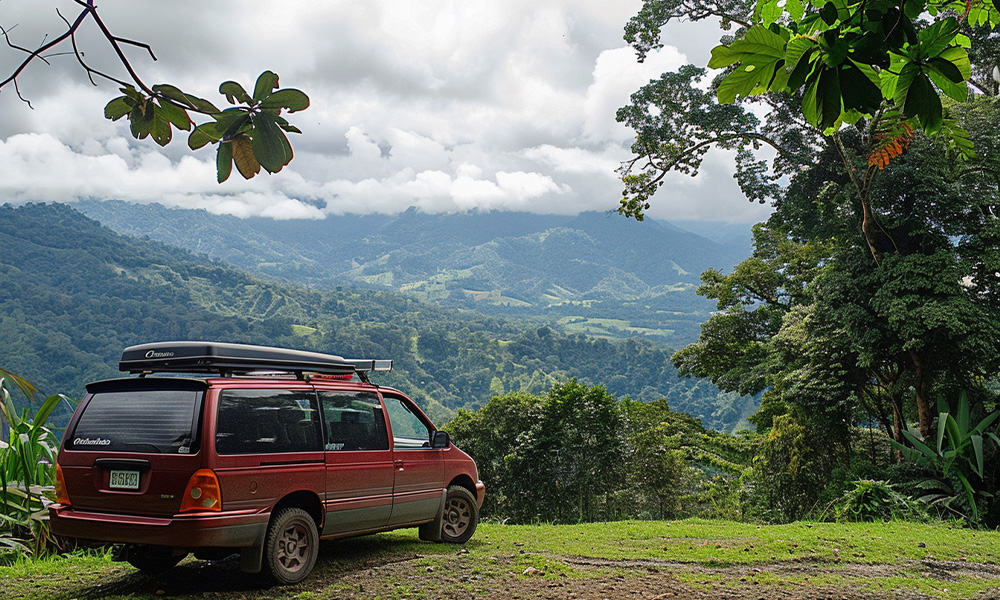Somewhere between the Pacific beaches of Manzanillo and Coyote is a dusty track, theoretically a road, that wades pebbled rivers and climbs into herds of white Brahman cows before plunging directly back to sea level. A driver could equally expect to round the corner into a beachy paradise or to face 50 meters of open river.
Hence, the dilemma: Do you drive slowly into the water for better traction and less splashing, or open the throttle, close your eyes and hit the river at highway speed? We were touring the Nicoya Peninsula in a 1995 Mercury Villager minivan – two-wheel drive, bad clearance. We crossed 11 rivers and went with choice “B” 11 times.
It is quiet and beautiful here, and the farther you go, the harder it is to turn around. We were vaguely bound for Nosara, where my wife, Rebeccah, and I got married in 2004. Tamarack, 3, was born in San José, but this was the first time he and Raven, 1, had seen the ocean. We peeled ourselves and a couple of friends away from Minnesota’s ice, borrowed the Mercury and pointed her west from San José.
We figured we’d cross the Gulf of Nicoya and make it to Montezuma, on the peninsula’s southern tip, by nightfall. We took the 3 p.m. ferry from the Central Pacific port city of Puntarenas, which dropped us an hour or so later in the village of Paquera. The price of this little cruise was $21 for four adults, two kids and a van. $21 is not a bad deal to blast out of Puntarenas in one shot.
I’m sure the town has its attributes, but they’re hard to find when you’re trapped in a minivan in the stifling midday heat on that barely vegetated finger of concrete and asphalt leading to the ferry terminal. Also, the ferry ride was a good place for my oldest boy to begin his long-anticipated search for dolphins, whales and water ladies. We didn’t find any, but we saw some rocky islands, a floating log and about 50 seagulls named Gary.
The road to Montezuma is mostly pavement with giant holes, and it’s fairly well marked – turn left at the sign with the missing arrow. Right away we noticed a few things: ¢560 doesn’t go as far as it used to, and it’s harder to party all night and laze around all day with little boys in tow. I never have figured out how to party all night, so that wasn’t much of a problem, although Tamarack was working on it from midnight until 2 a.m. our first night in Montezuma.
He went backwards, mustering all the tears and agony of a dramatic party for an hour, then drawing dolphins and other sea animals, with narration, of course, and lights on. Fan off.
Montezuma is hilly and goes right up to the curvy beach, which is nice for municipal ambience but makes the beach itself a bit townish. We didn’t find any dolphins, whales or water ladies here, either, so we took off pretty quick in the morning. Our boys got to see the real ocean, though, and Tamarack’s storybook fascination changed to terror with the first wave that crashed on his feet.
To get out of these seaside hamlets, you basically drive up a cliff to the inland trails, or drive the coastal trail, which also includes cliffs, and rivers. Crossing the southern tip of the peninsula, we went inland and back out to get to Malpaís and Santa Teresa. The towns there are a string of shops and lodges along a wide gravel road, with 100 meters or so of vegetation between the road and the beach.
From there we decided to try the “three-and-a-half-hour” coastal drive to Nosara. This corner of the map shows a spider-web of roads, but I think some of them are lies.
If we dipped the paper in truth serum and shook it to the light, half the lines would fade right off, most of the rest would turn into faint markings, and one or two would appear out of nowhere.
Lacking the knowledge of which roads are real, the foolhardy tourist can drive by a combination of intuition, or “feel,” and some friendly advice along the way. The general rule of interpreting distances and times is to multiply the hours by two-and-a-half and the number of river crossings by three.
This was the most serene and isolated part of our trip, and I told Tamarack we’d come back on motorcycles when he’s 16, or maybe 12. The only time the minivan seemed truly scared was when she heard, “It’s only an hour if you drive on the beach – but go quickly, because the tide is coming in. Do you have four-wheel drive?”
“Chirp chirp chirp! (No, I don’t! I don’t have four-wheel drive!)” she said, breaking into a wailing moan until we could find the button to calm her. (I hope the bird that chirps for these universal car alarms here gets a lot of royalties; it must have done an hour’s worth of chirping on our trip alone.)
Anyway, about six hours and four rivers into the three-and-a-half-hour, two-river drive, we found ourselves up a cliff without a Jeep. I’d gunned Li’l Merc halfway up a rutted hill and she skidded to a halt. The odds seemed equal that we’d roll off into the pasture, burn up the transmission or abandon the van and ride off on horses. But someone found a giant plank in the ditch, and two of us employed it as a lever behind the back bumper.
The lightest person who could reach the gas pedal pushed it, and we cleared the hump in a couple of lurches and shot off into paradise (not that paradise). We roared through Coyote, Islita, Carrillo and Sámara and arrived in Nosara after dark, just in time for another wild party. This time it was reading about dolphins.





